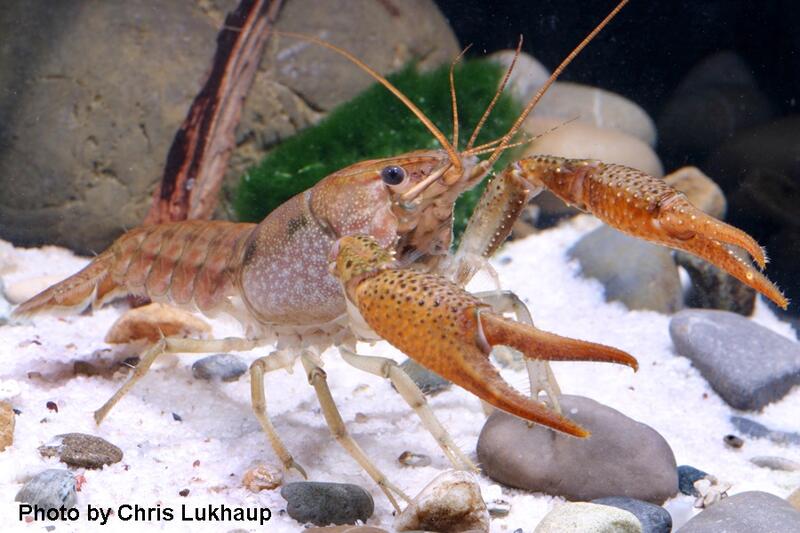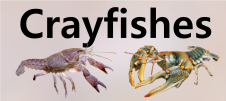







Loading profile. Please wait . . .
Procambarus seminolae Hobbs, 1942
Seminole Crayfish




Federal Protection: No US federal protection
State Protection: No Georgia state protection
Global Rank: G5
State Rank: S5
Element Locations Tracked in Biotics: No
SWAP 2015 Species of Greatest Conservation Need (SGCN): No
SWAP 2025 Species of Greatest Conservation Need (SGCN): No
2025 SGCN Priority Tier: None
Element Occurrences (EOs) in Georgia: 0
Habitat Summary for element in Georgia: Georgia habitat information not available
The carapace of the Seminole Crayfish is light brown or tan to dark reddish-brownish dorsally with a pale central stripe from the rostrum to the rear of the carapace. There are two discrete, dark spots on each side of the carapace and below them the sides have a brownish-pinkish hue with light irregular splotches. The abdomen has a wide dark or reddish dorsal stripe. The claws are brownish with dark tubercles and the areola is fairly wide. The rostrum is long, tapering, and usually somewhat convex in appearance; there may or may not be marginal spines or tubercles. If cervical spines or tubercles are present, they are very small (Hobbs 1981). This species reaches a maximum total body length of about 88 mm (3.5 in).
The Seminole Crayfish is widespread in southern Georgia and thus its range overlaps with many other species. The presence of two discrete spots on the upper sides separates this species from all others with which it could occur except the Black Mottled Crayfish, Procambarus enoplosternum. Black Mottled Crayfish usually has a larger cervical spine, but details of the male reproductive structure may need to be examined to separate these two species.
Seminole Crayfish live in a wide variety of habitats including streams, ponds, ditches, and swamps. It is frequently found in burrows where the water table remains within about 1 m of the ground surface.
No studies of the Seminole Crayfish are known. Crayfishes are considered opportunistic omnivores and likely feed on live and decaying vegetation, aquatic insect larvae, small fishes, and dead animal matter.
Seminole Crayfish is found in both open water and simple burrows. Reproduction likely occurs during the spring and fall, but males in reproductive condition may be found at any time during the year. When female crayfish are ready to lay eggs, they usually find a secure hiding place and hence are rarely encountered. After the eggs are released, the female attaches them to her swimmerets and is said to be “in berry.” Upon hatching, the juvenile crayfish are attached to the mother by a thread. After the juveniles molt for the second time, they are free of the mother, but stay close and will hold on to her for some time. Eventually they move off on their own. Crayfishes molt 6 or 7 times during their first year of life and most are probably able to reproduce by the end of that year. They molt once or twice a year for the remainder of their lives and live about 3 years. Including data from Georgia and Florida, male Seminole Crayfish in reproductive condition have been collected in every month of the year (Hobbs 1981). Females with eggs and young have been found in September and October in Georgia and a female with eggs was collected in November in Florida. The smallest breeding male known is about 44 mm (1.7 in) and the smallest Georgia female carrying eggs is about 41 mm (1.6 in) in length (Hobbs 1981).
Since this species is found in a variety of habitats, using a seine or dipnet in streams and/or ponds can yield the species. Excavating burrows adjunct to temporary habitats or stream margins may also produce this species.
The Seminole Crayfish ranges primarily from south of the Altamaha River basin, south to northern Florida. In Georgia it is also known from two or three locations in the Flint River system and from the lower end of the Oconee and Ohoopee river systems. A single collection from Bryan County in the Canoochee River system probably represents and introduction (Hobbs 1981).
This species is threatened in Georgia by land uses within its range that could alter hydrology and water quality. Introduction of non-native species is a threat to all native crayfishes.
This species is common and widespread in Georgia and is thus considered secure.
General watershed level protection measures will help secure the continued existence of the Seminole Crayfish in Georgia. These include the protection of riparian zones, control of sediment and nutrient runoff from farms and construction sites, and limiting the amount of impervious cover (e.g., pavement) within occupied watersheds. Non-native crayfishes should never be used for bait. Instead, anglers should use crayfishes collected from the river system they will be fishing in and should never release unused bait crayfish back into Georgia waters.
Hobbs, H.H., Jr. 1981. The crayfishes of Georgia. Smithsonian Contributions to Zoology 318:1–549.
Taylor, C.A., G.A. Schuster, J.E. Cooper, R.J. DiStefano, A.G. Eversole, P. Hamr, H.H. Hobbs III, H.W. Robison, C.E. Skelton, and R.F. Thoma. 2007. A reassessment of the conservation status of crayfishes of the United States and Canada after 10+ years of increased awareness. Fisheries 32:372–389.
Christopher E. Skelton
C. Skelton, August 2012: original account
C. Skelton, March 2019: general update of account.
D.Weiler, September 2019: photo added